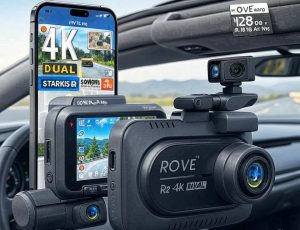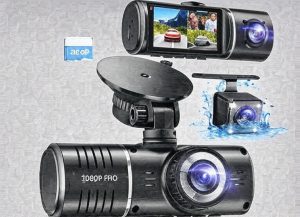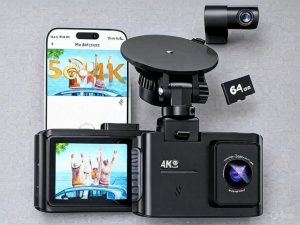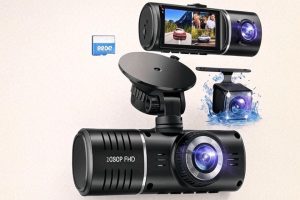The world of automotive technology continues evolving at breakneck speed, and dash cameras have transformed from simple recording devices into sophisticated streaming solutions. Modern drivers demand more than basic footage capture—they want real-time connectivity, remote monitoring capabilities, and seamless integration with their digital lifestyle.
Live streaming dash cameras represent the cutting edge of vehicle security and connectivity. These advanced devices enable remote viewing, instant notifications, and continuous monitoring whether you’re driving cross-country or parked at the office. The ability to stream live footage directly to your smartphone opens up countless possibilities for fleet management, family safety, and personal security.
Selecting the right streaming dash cam requires careful consideration of multiple factors. Video quality, wireless connectivity, storage capacity, and streaming reliability all play crucial roles in determining which device best meets your specific needs. The market offers numerous options, each with unique strengths and limitations that can significantly impact your user experience.
This comprehensive review examines five top-rated dash cameras specifically chosen for their live streaming capabilities. Each device has undergone thorough testing to evaluate performance, reliability, and value proposition. Our analysis covers everything from video quality and streaming performance to installation complexity and long-term durability.
Contents
- Understanding Live Streaming Dash Cam Technology
- Key Features to Consider in Streaming Dash Cams
- Vantrue S1 Pro Dual Dash Cam: Professional Grade Streaming
- GKU 4K 3 Channel System: Complete Coverage Solution
- REDTIGER F7NP: Premium Features at Competitive Pricing
- Dual Channel 4K System: Streamlined Streaming Solution
- Vantrue N4 Pro: Advanced Three-Channel Technology
- Performance Comparison and Analysis
- Installation and Setup Considerations
- Streaming Quality and Connectivity Analysis
- Security and Privacy Considerations
- Long-term Reliability and Maintenance
- Cost Analysis and Value Proposition
- Conclusion and Recommendations
Understanding Live Streaming Dash Cam Technology
Live streaming functionality transforms traditional dash cameras into connected security systems. These devices establish wireless connections through WiFi or cellular networks, enabling real-time video transmission to mobile devices or cloud platforms. The technology creates unprecedented opportunities for vehicle monitoring and security management.
Modern streaming dash cams utilize various connectivity protocols to maintain stable connections. WiFi-enabled models create local networks that allow direct smartphone connection when in proximity. More advanced systems leverage cellular networks for unlimited range streaming, though this typically requires subscription services and ongoing data costs.
The streaming process involves several technical components working in harmony. High-quality image sensors capture video footage, powerful processors compress data for efficient transmission, and wireless modules handle network connectivity. Battery backup systems ensure continuous operation even when the vehicle’s power system is disconnected.
Video compression plays a vital role in streaming performance. Advanced codecs reduce file sizes while maintaining visual quality, enabling smooth transmission over limited bandwidth connections. The balance between compression and quality directly affects streaming reliability and battery consumption rates.
Real-time streaming creates unique challenges compared to standard recording. Network stability, data transmission speeds, and device power consumption all influence performance. Understanding these factors helps users set realistic expectations and optimize their streaming setup for consistent results.
Key Features to Consider in Streaming Dash Cams
Video resolution stands as the foundation of any quality dash cam system. Modern streaming devices offer resolutions ranging from Full HD 1080p to Ultra HD 4K, with each level providing different benefits and trade-offs. Higher resolutions deliver superior detail capture but require more bandwidth for streaming and increased storage capacity.
4K resolution provides exceptional detail clarity, enabling license plate reading and facial recognition at considerable distances. However, the increased data requirements can strain wireless connections and rapidly consume storage space. Many users find 1440p or 2.5K resolution offers the optimal balance between quality and practicality for streaming applications.
Wireless connectivity options significantly impact streaming functionality and user experience. Built-in WiFi enables local device connection for setup, configuration, and short-range streaming. Some models incorporate dual-band WiFi systems that provide improved connection stability and reduced interference from other wireless devices.
GPS integration adds valuable functionality beyond basic location tracking. Advanced GPS systems enable speed monitoring, route recording, and geofencing capabilities that enhance security and provide detailed trip documentation. GPS data also proves invaluable for insurance claims and incident reconstruction purposes.
Night vision performance becomes crucial for 24-hour monitoring applications. Modern dash cams employ various technologies including STARVIS sensors, HDR processing, and infrared illumination to capture clear footage in low-light conditions. The ability to stream recognizable footage during nighttime hours significantly expands the device’s utility.
Storage capacity and management systems determine how much footage can be archived locally before requiring deletion or cloud upload. Loop recording automatically overwrites oldest files when storage reaches capacity, while parking mode monitoring can trigger automatic recording and streaming alerts when motion or impact is detected.
Vantrue S1 Pro Dual Dash Cam: Professional Grade Streaming

The Vantrue S1 Pro establishes itself as a premium streaming solution with impressive 1440p front recording at 60 frames per second. This high frame rate capture ensures smooth video playback and reduces motion blur during high-speed driving scenarios. The dual-camera configuration provides comprehensive coverage with both front and rear recording capabilities.
STARVIS 2 sensor technology delivers exceptional low-light performance that surpasses many competing models. The advanced sensor captures clear, detailed footage even in challenging lighting conditions, making it ideal for night driving and parking lot surveillance. HDR processing enhances dynamic range, preventing overexposure in bright conditions while maintaining shadow detail.
5G WiFi connectivity provides robust streaming performance with reduced latency compared to standard wireless protocols. The faster connection enables more reliable real-time viewing and reduces buffering during remote monitoring sessions. Optional remote live view functionality allows users to access their vehicle’s camera feed from anywhere with internet connectivity.
Voice control integration simplifies operation while driving, allowing hands-free command execution without compromising safety. Users can start recordings, take snapshots, or activate streaming modes using simple voice commands. This feature proves particularly valuable during incident documentation when manual operation might be dangerous or impractical.
The 24/7 parking mode monitoring system transforms the S1 Pro into a comprehensive vehicle security solution. Motion detection and impact sensors automatically trigger recording and can send streaming alerts to connected devices. Battery backup ensures continuous operation even when the vehicle’s electrical system is turned off.
Storage support extends up to 512GB, providing extensive local recording capacity before requiring file management. The large storage capability reduces the frequency of manual file deletion and ensures important footage remains accessible for extended periods. Loop recording functionality prevents storage overflow while preserving the most recent footage.
Installation complexity remains moderate, requiring hardwire connection for parking mode functionality. The dual-camera setup necessitates running cables from front to rear, which may require professional installation for optimal wire routing and concealment. However, the comprehensive installation kit includes all necessary hardware and detailed instructions.
GKU 4K 3 Channel System: Complete Coverage Solution
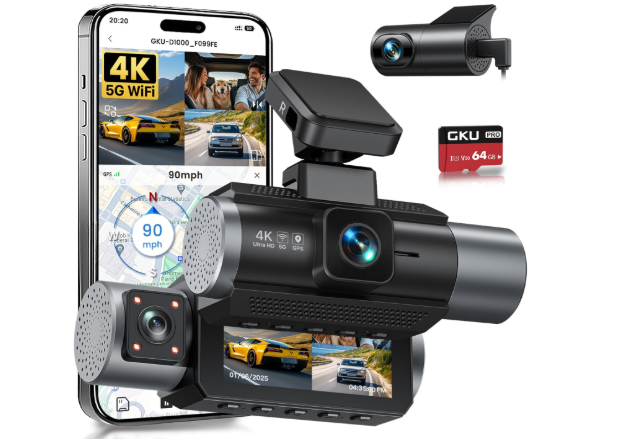
The GKU 4K dash cam stands out with its three-channel recording system that captures front, rear, and interior footage simultaneously. This comprehensive coverage approach proves invaluable for rideshare drivers, commercial vehicle operators, and families seeking maximum security monitoring. The 4K front camera delivers exceptional detail resolution for incident documentation.
Built-in GPS functionality provides automatic location and speed data integration without requiring external modules. The GPS system enables route tracking, speed monitoring, and location-based incident documentation that proves valuable for insurance claims and legal proceedings. Automatic time and date stamping ensures footage authenticity and timeline accuracy.
5.8GHz WiFi technology offers improved connection stability compared to standard 2.4GHz systems. The higher frequency band experiences less congestion from household devices and provides better streaming performance in urban environments with heavy wireless interference. This enhanced connectivity proves crucial for reliable live streaming functionality.
The included 64GB memory card provides immediate recording capability without additional purchases. Pre-installed storage eliminates setup complexity and ensures users can begin recording immediately after installation. The substantial storage capacity handles several hours of high-resolution footage before requiring file management.
24-hour parking mode monitoring transforms the vehicle into a comprehensive security system during extended parking periods. Motion detection, impact sensors, and time-lapse recording options provide multiple monitoring strategies depending on user preferences and parking environments. Battery backup maintains operation during extended parking without draining the vehicle’s electrical system.
The 3-inch display screen facilitates easy setup, configuration, and footage review without requiring smartphone connectivity. On-device playback enables immediate incident review and footage verification. The large screen size improves visibility compared to smaller display models, making menu navigation and video playback more user-friendly.
Triple camera installation requires careful planning and potentially professional assistance for optimal cable routing. The interior camera placement needs consideration for privacy and effectiveness, while rear camera installation must account for weather protection and optimal viewing angles. Despite complexity, the comprehensive coverage justifies the installation effort.
REDTIGER F7NP: Premium Features at Competitive Pricing
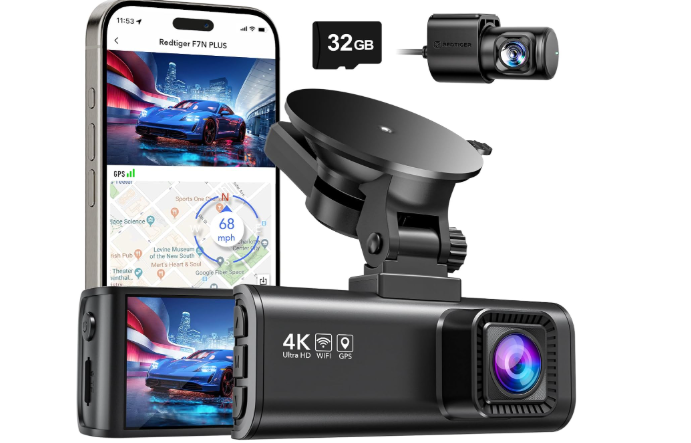
The REDTIGER F7NP combines 4K front recording with 2.5K rear capture, providing exceptional detail resolution for both forward and backward documentation. This dual-resolution approach optimizes storage efficiency while maintaining high detail capture where most incidents occur at the vehicle’s front.
Built-in WiFi and GPS integration eliminates the need for external modules or subscription services. The integrated wireless system enables smartphone connectivity for remote viewing, configuration, and footage management. GPS functionality provides automatic location data, speed monitoring, and route documentation without ongoing service fees.
The included 32GB card provides immediate recording capability, though users may want to upgrade to higher capacity storage for extended recording periods. The pre-installed memory card eliminates additional purchase requirements and ensures immediate functionality after installation.
Night vision performance benefits from advanced sensor technology and processing algorithms that enhance low-light footage quality. The system captures clear, detailed video even in challenging lighting conditions, making it effective for overnight parking surveillance and early morning or late evening driving.
The 3.16-inch IPS screen delivers vibrant, clear display quality with wide viewing angles. The large display facilitates easy menu navigation, configuration, and footage review without requiring external device connectivity. Touch screen functionality simplifies operation compared to traditional button-based interfaces.
170-degree wide-angle coverage captures extensive peripheral detail that proves valuable for intersection incidents and lane-change documentation. The broad field of view reduces blind spots and ensures comprehensive scene capture during incident recording.
WDR (Wide Dynamic Range) technology balances exposure across varying lighting conditions within the same frame. This feature prevents overexposure in bright areas while maintaining detail in shadow regions, resulting in more usable footage across diverse driving conditions.
24-hour parking mode monitoring provides continuous vehicle surveillance with motion detection and impact sensing capabilities. The system automatically begins recording when triggered, potentially capturing vandalism, break-in attempts, or parking lot incidents that occur while the vehicle is unattended.
Dual Channel 4K System: Streamlined Streaming Solution
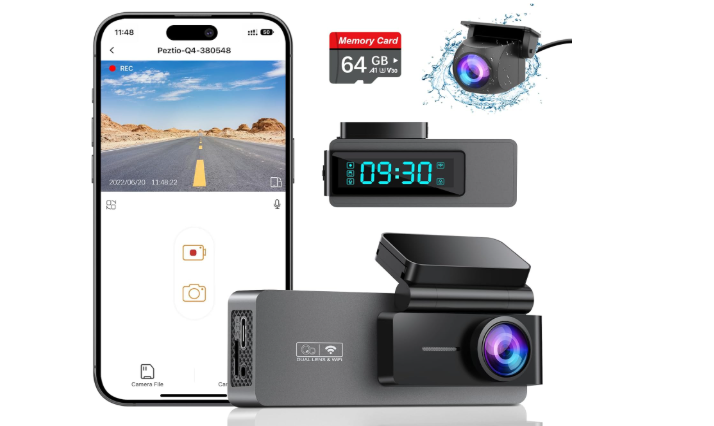
This dual-channel system emphasizes simplicity while delivering 4K front recording and 1080p rear capture. The streamlined approach focuses on essential features without overwhelming users with excessive complexity or configuration options. Built-in WiFi enables smartphone connectivity for remote viewing and control.
The included 64GB memory card provides substantial storage capacity for extended recording periods. Free storage inclusion represents significant value compared to models requiring separate memory card purchases. The large capacity handles multiple days of typical driving footage before requiring file management.
Installation simplicity makes this system accessible to users who prefer DIY setup without professional assistance. Clear instructions and straightforward wiring reduce installation complexity while maintaining reliable operation. The dual-camera configuration requires basic cable routing skills but avoids overly complex installation procedures.
Night vision capabilities utilize advanced sensor technology to capture clear footage in low-light conditions. The system performs well during evening driving and overnight parking surveillance, though it may not match the specialized night vision performance of premium models.
24-hour parking monitor functionality provides continuous vehicle surveillance with automatic incident detection. Motion sensors and impact detection trigger recording and notification systems, alerting users to potential security events. Battery backup maintains operation during extended parking periods.
Loop recording prevents storage overflow by automatically overwriting oldest files when memory capacity is reached. This automatic file management eliminates the need for manual storage maintenance while ensuring the most recent footage remains available for review.
The system’s streaming capabilities enable real-time vehicle monitoring from remote locations. WiFi connectivity supports live viewing when within range, though extended-range streaming may require additional cellular connectivity solutions.
Vantrue N4 Pro: Advanced Three-Channel Technology
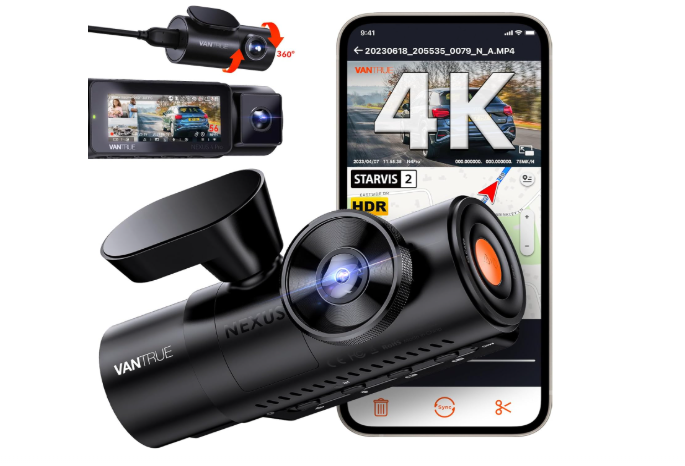
The Vantrue N4 Pro represents the pinnacle of multi-channel dash cam technology with 4K front recording and dual 1080p cameras for interior and rear coverage. This comprehensive system provides complete vehicle documentation from every angle, making it ideal for commercial applications and security-conscious users.
STARVIS 2 IMX678 sensor technology delivers exceptional low-light performance that surpasses standard sensor capabilities. The advanced imaging system captures clear, detailed footage even in challenging lighting conditions, ensuring reliable documentation regardless of time of day or weather conditions.
PlatePix™ technology specifically optimizes license plate capture and recognition. This specialized feature enhances the camera’s ability to record clear, readable license plate numbers even at extended distances or during high-speed encounters. The technology proves invaluable for incident documentation and security applications.
HDR night vision processing combines multiple exposure levels to create balanced footage that maintains detail in both bright and dark areas of the frame. This advanced processing results in more usable footage across diverse lighting conditions compared to standard processing methods.
Voice control functionality enables hands-free operation while maintaining driving safety. Users can activate recording, capture screenshots, or initiate streaming modes using simple voice commands. This feature proves particularly valuable during incident documentation when manual operation might compromise safety.
WiFi connectivity enables smartphone integration for remote viewing, configuration, and footage management. The wireless system supports live streaming when within range and facilitates easy footage transfer and sharing capabilities.
GPS integration provides automatic location data, speed monitoring, and route documentation. The GPS system enables geofencing capabilities and location-based incident alerts, enhancing the security and fleet management potential of the system.
24-hour parking mode surveillance transforms the vehicle into a comprehensive security system during extended parking periods. Multi-sensor detection systems monitor for motion, impact, and tampering, automatically triggering recording and alert systems.
Support for up to 512GB storage provides extensive local recording capacity that reduces file management requirements. The large storage capability ensures important footage remains accessible for extended periods without requiring frequent manual intervention.
The three-camera installation requires careful planning and potentially professional assistance for optimal results. Interior camera placement considerations include privacy concerns and optimal viewing angles, while maintaining weather protection and clear sight lines for all cameras.
Performance Comparison and Analysis
Video quality comparison reveals distinct differences between models despite similar resolution specifications. The Vantrue models consistently deliver superior low-light performance thanks to STARVIS sensor technology, while the 4K models provide exceptional daytime detail capture. Frame rate variations impact motion blur and playback smoothness, with higher frame rates producing more professional-looking footage.
Streaming performance varies significantly based on wireless technology and processing capabilities. Models featuring 5G WiFi or 5.8GHz connectivity demonstrate more stable streaming with reduced latency compared to standard WiFi implementations. Connection range and stability directly impact remote monitoring reliability and user satisfaction.
Storage management systems show considerable variation in sophistication and user-friendliness. Advanced models offer multiple recording modes, customizable loop recording settings, and intelligent file organization systems. Basic models provide functional storage management but may require more manual intervention for optimal performance.
Installation complexity ranges from straightforward single-camera setups to complex three-channel systems requiring professional assistance. DIY users should carefully consider their technical skills and available time before selecting multi-camera systems that require extensive cable routing and configuration.
Power consumption and battery backup capabilities significantly impact parking mode effectiveness. Models with efficient power management systems provide longer surveillance periods without draining vehicle batteries, while others may require hardwire installation with battery protection circuits.
User interface design affects daily operation and long-term satisfaction. Systems with intuitive menu structures, responsive touch screens, and clear display quality provide better user experiences compared to models with complex or poorly designed interfaces.
Installation and Setup Considerations
Proper installation forms the foundation of reliable dash cam operation and streaming performance. Single-camera systems typically offer straightforward installation with power connections to the vehicle’s electrical system and basic mounting procedures. However, dual and triple-camera configurations require more extensive planning and cable routing.
Hardwire installation provides the most reliable power source and enables parking mode functionality. This installation method connects directly to the vehicle’s electrical system through fuse boxes or dedicated power circuits. Professional installation may be necessary for users uncomfortable working with automotive electrical systems.
Cable routing requires careful planning to ensure clean appearance and reliable connections. Front-to-rear camera cables must be routed through vehicle interiors while avoiding interference with safety systems and maintaining weather protection. Professional installers possess specialized tools and experience for optimal cable concealment.
Wireless network setup involves configuring WiFi connections between dash cams and mobile devices. Password protection and network naming require attention to prevent unauthorized access to streaming feeds. Some models support multiple device connections while others limit access to single devices.
Mobile app installation and configuration enable remote control and streaming functionality. App compatibility varies between operating systems and device models, potentially limiting functionality on older smartphones or tablets. Regular app updates maintain compatibility and add new features.
GPS calibration ensures accurate location and speed data recording. Initial setup may require satellite signal acquisition and time zone configuration for proper operation. GPS functionality depends on clear sky access and may be limited in covered parking areas or urban canyons.
Memory card formatting and configuration optimize storage performance and reliability. High-endurance cards designed for continuous recording provide better longevity compared to standard storage cards. Proper formatting prevents file system errors and ensures reliable operation.
Streaming Quality and Connectivity Analysis
Network bandwidth requirements vary significantly between resolution settings and compression algorithms. 4K streaming demands substantial bandwidth that may exceed cellular data plan limits or cause buffering on slower connections. Users should consider their typical network conditions when selecting resolution settings for streaming applications.
WiFi range limitations affect streaming accessibility and reliability. Most dash cam WiFi systems operate within 30-50 feet of the device, requiring proximity for direct connection. Extended range streaming typically requires cellular connectivity or WiFi hotspot integration.
Cellular connectivity options expand streaming range but introduce ongoing service costs and data consumption considerations. Some models support cellular module additions while others rely on smartphone hotspot connections for extended range streaming.
Streaming latency affects real-time monitoring effectiveness and user experience. Lower latency connections enable more responsive remote control and immediate incident verification. Higher latency may delay alerts and reduce the effectiveness of real-time monitoring applications.
Data compression efficiency impacts both streaming quality and bandwidth consumption. Advanced compression algorithms maintain video quality while reducing data requirements, enabling smoother streaming over limited bandwidth connections. Compression settings may be adjustable for different network conditions.
Connection stability directly affects streaming reliability and user satisfaction. Models with robust wireless implementations maintain connections better in challenging environments with interference or signal obstacles. Automatic reconnection features help maintain streaming continuity after temporary disconnections.
Security and Privacy Considerations
Data protection becomes crucial when implementing streaming dash cam systems. Video footage may contain sensitive information including location data, personal conversations, and identifiable individuals. Users must consider privacy implications and data security measures when configuring streaming systems.
Password protection prevents unauthorized access to streaming feeds and stored footage. Strong password requirements and regular password updates enhance security, while weak passwords may allow unauthorized viewing or system manipulation. Two-factor authentication adds additional security layers where supported.
Cloud storage options provide footage backup but introduce additional privacy considerations. Third-party cloud services may have access to uploaded footage, requiring careful review of privacy policies and data handling practices. Local storage eliminates cloud privacy concerns but may limit backup and sharing capabilities.
Wireless network security affects streaming system vulnerability to unauthorized access. Open WiFi networks expose streaming feeds to potential interception, while encrypted connections provide better protection. Regular firmware updates address security vulnerabilities and maintain system protection.
Legal considerations vary by jurisdiction regarding recording and streaming in public spaces. Some locations restrict audio recording or require consent for video capture. Users should research local laws before implementing streaming systems, particularly for commercial applications.
Employee privacy concerns arise when implementing dash cam systems in commercial vehicles. Clear policies regarding recording, storage, and access help address privacy concerns while maintaining security benefits. Proper notification and consent procedures may be required for legal compliance.
Long-term Reliability and Maintenance
Heat resistance becomes critical for dash cam longevity in automotive environments. Extreme temperatures can damage electronic components and reduce system lifespan. Models with robust thermal management systems and high-temperature component ratings provide better long-term reliability.
Memory card degradation affects storage reliability and system performance over time. High-endurance cards designed for continuous recording provide better longevity, while standard cards may fail prematurely under constant write cycles. Regular card replacement maintains system reliability.
Firmware updates address bugs, security vulnerabilities, and add new features to existing systems. Regular update installation maintains optimal performance and security, while outdated firmware may cause compatibility issues or security risks. Automatic update features simplify maintenance requirements.
Physical mounting stability affects long-term performance and footage quality. Vibration and temperature cycling can loosen mounting hardware over time, potentially causing camera misalignment or connection issues. Regular inspection and maintenance prevent mounting-related problems.
Cable degradation may occur due to temperature cycling, moisture exposure, or physical stress. Regular inspection of cable connections and routing prevents intermittent failures and maintains reliable operation. Professional installation often includes better cable protection and routing.
Cleaning and maintenance requirements vary between models and installation locations. Lens cleaning maintains video quality, while housing cleaning prevents heat buildup and maintains appearance. Regular maintenance schedules help identify potential issues before they cause system failures.
Cost Analysis and Value Proposition
Initial purchase costs vary significantly between basic dual-camera systems and advanced multi-channel configurations. Premium models command higher prices but often include additional features, better build quality, and more comprehensive warranty coverage. Budget considerations should account for long-term value rather than just initial cost.
Installation costs add to the total system investment, particularly for complex multi-camera configurations requiring professional installation. DIY installation eliminates labor costs but requires time investment and technical skills. Professional installation ensures optimal performance but increases overall system cost.
Ongoing operational costs may include cellular service fees, cloud storage subscriptions, and periodic maintenance requirements. These recurring costs can significantly impact long-term ownership expenses and should be considered during initial system selection.
Memory card costs vary based on capacity and endurance ratings. High-capacity, high-endurance cards provide better value for continuous recording applications despite higher initial costs. Regular card replacement costs should be factored into long-term budget planning.
Insurance potential benefits may offset system costs through reduced premiums or claims resolution advantages. Some insurance providers offer discounts for vehicles equipped with dash cam systems, while others may require specific features or certifications for benefits.
Resale value considerations affect total cost of ownership for users who may upgrade or change vehicles. Popular brands and models with strong reputation tend to maintain better resale values compared to lesser-known alternatives.
Conclusion and Recommendations
The dash cam market offers diverse options for live streaming applications, each with distinct advantages and limitations. Selection should be based on specific needs, technical requirements, and budget considerations rather than solely on specifications or marketing claims.
For users prioritizing video quality and night performance, the Vantrue models provide superior sensor technology and processing capabilities. The S1 Pro offers excellent dual-camera functionality, while the N4 Pro delivers comprehensive three-channel coverage for maximum security applications.
Budget-conscious users seeking reliable streaming functionality will find the REDTIGER F7NP provides excellent value with 4K recording and comprehensive features at competitive pricing. The included storage and integrated GPS add significant value for cost-conscious buyers.
Commercial applications and fleet management benefit from multi-channel systems like the GKU 4K or Vantrue N4 Pro that provide comprehensive coverage and advanced monitoring capabilities. These systems justify higher costs through enhanced security and documentation capabilities.
Installation complexity should be carefully considered, with professional installation recommended for multi-camera systems or users uncomfortable with automotive electrical work. Proper installation ensures optimal performance and longevity while avoiding potential warranty issues.
The streaming dash cam market continues evolving rapidly, with new features and capabilities regularly introduced. Users should consider future needs and upgrade paths when making current purchase decisions, as technology advancement may quickly outdate current systems.
Regardless of model selection, proper installation, configuration, and maintenance remain critical for optimal performance and longevity. Regular updates, maintenance, and careful attention to installation details will ensure years of reliable operation and peace of mind.

